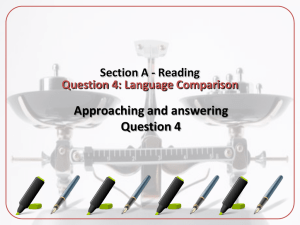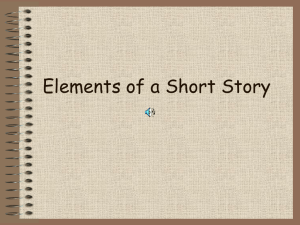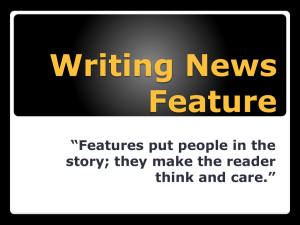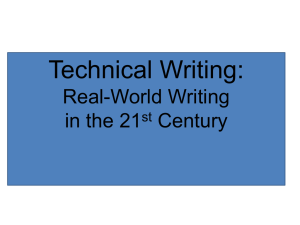Reading - Guiseley School
advertisement
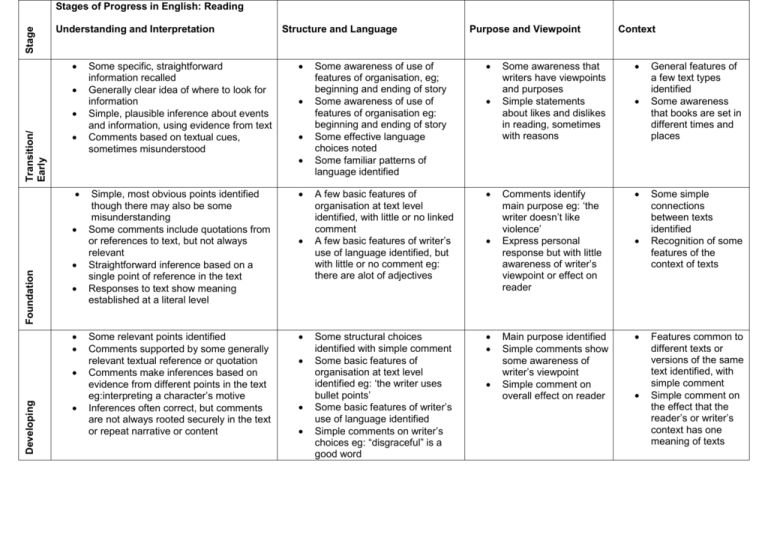
Stage Stages of Progress in English: Reading Understanding and Interpretation Transition/ Early Foundation Developing Structure and Language Some specific, straightforward information recalled Generally clear idea of where to look for information Simple, plausible inference about events and information, using evidence from text Comments based on textual cues, sometimes misunderstood Simple, most obvious points identified though there may also be some misunderstanding Some comments include quotations from or references to text, but not always relevant Straightforward inference based on a single point of reference in the text Responses to text show meaning established at a literal level Some relevant points identified Comments supported by some generally relevant textual reference or quotation Comments make inferences based on evidence from different points in the text eg:interpreting a character’s motive Inferences often correct, but comments are not always rooted securely in the text or repeat narrative or content Purpose and Viewpoint Some awareness of use of features of organisation, eg; beginning and ending of story Some awareness of use of features of organisation eg: beginning and ending of story Some effective language choices noted Some familiar patterns of language identified A few basic features of organisation at text level identified, with little or no linked comment A few basic features of writer’s use of language identified, but with little or no comment eg: there are alot of adjectives Some structural choices identified with simple comment Some basic features of organisation at text level identified eg: ‘the writer uses bullet points’ Some basic features of writer’s use of language identified Simple comments on writer’s choices eg: “disgraceful” is a good word Context Some awareness that writers have viewpoints and purposes Simple statements about likes and dislikes in reading, sometimes with reasons Comments identify main purpose eg: ‘the writer doesn’t like violence’ Express personal response but with little awareness of writer’s viewpoint or effect on reader Main purpose identified Simple comments show some awareness of writer’s viewpoint Simple comment on overall effect on reader General features of a few text types identified Some awareness that books are set in different times and places Some simple connections between texts identified Recognition of some features of the context of texts Features common to different texts or versions of the same text identified, with simple comment Simple comment on the effect that the reader’s or writer’s context has one meaning of texts Stage Understanding and Interpretation Secure Most relevant points clearly identified, including those selected from different places in the text Comments generally supported by relevant textual reference or quotation, even when points made are not always accurate Comments develop explanation of inferred meanings drawing on evidence across the text Comments make inferences and deductions based on textual evidence Structure and Language Established Relevant points clearly identified, including summary and synthesis of information from different sources or different places in the same text Commentary incorporates apt textual reference and quotation to support main ideas or argument Comments securely based in textual evidence and identify different layers of meaning, with some attempt at detailed exploration of them Comments consider wider implications or significance of information, events or ideas in the text Comments on structural choices show some general awareness if writer’s craft Various features relating to organisation at text level, including form, are clearly identified, with some explanation, eg: ‘each section starts with a question’ Various features of writer’s use of language identified, with some explanation Comments show some awareness of the effect of writer’s language choices Some detailed exploration of how structural choices support the writer’s theme or purpose Comment on how a range of features relating to organisation at text level contribute to the effects achieved eg: how the writer builds up to an unexpected ending Some detailed explanation, with appropriate terminology, of how language is used, eg: tracing an image Some drawing together of comments on how the writer’s language choices contribute to the overall effect on the reader Purpose and Viewpoint Context Main purpose clearly identified, often through general overview eg: ‘the writer is strongly against war’ Viewpoint in texts clearly identified, with some, often limited explanation General awareness of effect on the reader, with some, often limited, explanation Evidence for identifying main purpose precisely located at word/sentence level or traced through a text eg: commenting on repetition Viewpoint clearly identified and explanation of it developed through close reference to the text The effect on the reader clearly identified, with some explicit explanation as to how that effect has been created Comments identify similarities and differences between texts, or versions, with some explanation Some explanation of how the contexts in which texts are written and read contribute to meaning Some exploration of textual conventions or features as used by writers from different periods Some detailed discussion of how the contexts in which texts are written and read affect meaning Stage Understanding and Interpretation Confident Increasing precision in selection and application of textual reference to the point being made Increasing ability to draw on knowledge of other sources to develop or clinch an argument Comments begin to develop an interpretation of the text(s), making connections between insights, teasing out meanings or weighing up evidence Structure and Language Expert Clear critical stance develops a coherent interpretation of text(s), drawing on imaginative insights and well supported by reference and wider textual knowledge Purpose and Viewpoint Some evaluation of the extent to which structural choices support the writer’s theme or purpose, eg: exploration of a play’s plot and subplot Some appreciation of the skill with which a range of features relating to organisation at text level are used eg: evaluating or comparing the effectiveness of time switches Comments begin to develop precise, perceptive analysis of how language is used Some appreciation of how the writer’s language choices contribute to the overall effect on the reader Clear appreciation and understanding of how the text structure and language use support the writer’s purpose and contribute to meaning Responses begin to develop some analytical or evaluative comment on the writer’s purpose Responses begin to develop some analytical or evaluative comment on how viewpoint is established or managed across a text eg: tracing how a persona is established Responses begin to develop an appreciation of how particular techniques and devices achieve the effects they do Response to overall effect of the text shows clear understanding and critical evaluation of writer’s purposes and viewpoints and how these are articulated throughout the text Context Responses begin to show some analysis of how a text is influenced by earlier texts written within the same tradition Some analysis of how different meanings and interpretations of a text relate to the contexts in which it was written or read Sustained critical analysis/evaluation of the text(s) shows appreciation of how it relates to context(s) and tradition(s) and explores the meanings produced from it






